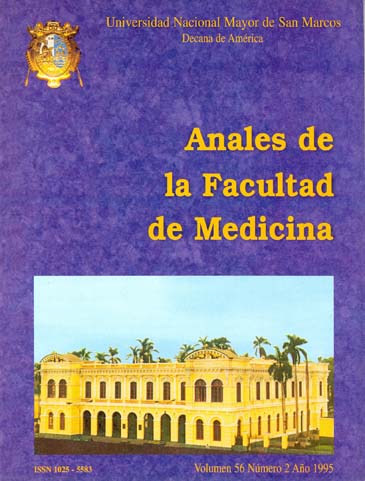Fetal growth in a population group in Lima
DOI:
https://doi.org/10.15381/anales.v56i2.5235Keywords:
Fetal growth, retardation, nutrition, surveillance, epidemiology, populationAbstract
Fetal growth is both an index of fetal well-being and predictor of early development of chronic diseases during extrauterine life. Therefore, it is neccesary to establish fetal growth standard. Based on 18,615 single deliveries registered at San Bartolome's Hospital in Lima, Peru, between June 1990 and March 1995, only 5,399 (29%) healthy Peruvian pregnant women less than 35 years old with no obstetrical complications had a healthy baby. We did not consider healthy a baby born before 34 weeks of gestation. Ten, 50, and 90 fetal weight percentiles were similar to those reported in developed countries. The differences of fetal weight between races has depended primarily on poverty and ignorance. Both factors are due to chronic underourishment and have generational influence modyfing maternal height, pelvis, lutritional status before conception and caloric ingestion during pregnancy as well as fetal wight.Downloads
Published
1995-12-29
Issue
Section
Trabajos originales
License
Copyright (c) 1995 Percy Pacora

This work is licensed under a Creative Commons Attribution-NonCommercial-ShareAlike 4.0 International License.
Those authors who have publications with this magazine accept the following terms:
- Authors will retain their copyrights and guarantee the journal the right of first publication of their work, which will be simultaneously subject to Creative Commons Attribution License that allows third parties to share the work as long as its author and its first publication this magazine are indicated.
- Authors may adopt other non-exclusive licensing agreements for the distribution of the version of the published work (eg, deposit it in an institutional electronic file or publish it in a monographic volume) provided that the initial publication in this magazine is indicated.
- Authors are allowed and recommended to disseminate their work over the Internet (eg: in institutional telematic archives or on their website) before and during the submission process, which It can produce interesting exchanges and increase quotes from the published work. (See El efecto del acceso abierto ).
How to Cite
1.
Pacora P. Fetal growth in a population group in Lima. An Fac med [Internet]. 1995 Dec. 29 [cited 2025 May 24];56(2):12-6. Available from: https://revistasinvestigacion.unmsm.edu.pe/index.php/anales/article/view/5235



